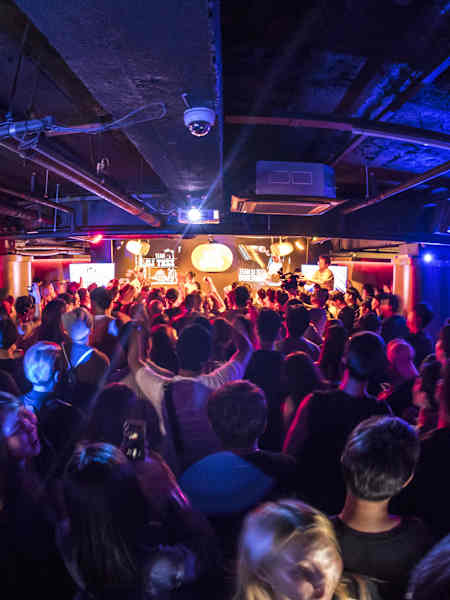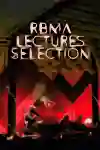With the highly anticipated return of Red Bull Back2Beyond, where four DJs will ignite the dancefloor in Paris, France, we've pulled out our music history books to share insights and fun facts with fans of electronic music. After exploring the great electro glossary, we now take a closer look at the history of this musical movement that's taken the world by storm.

Despite common misconceptions, electronic music dates back quite far, to the mid-19th century. Let’s take a look at its early beginnings and some key moments that have shaped the history of electro.
01
History and evolution of electronic music
Several dates can be considered as the starting point of electronic music. While some point to the '70s and '80s, it can be traced back to the '40s and '50s. At that time, a French engineer named Pierre Schaeffer, who worked in the audiovisual field, began experimenting with vinyl records to create new sounds. In 1948, he began talking about musique concrète, a vision where traditional notes and music theory would be set aside to focus on raw sound, regardless of the creative process.
Two decades later, two Germans from Düsseldorf, Ralf Hütter and Florian Schneider, formed the band Kraftwerk in the early 1970s. With their avant-garde music based on drum machines, the use of vocoders and numerous repetitions, they became the first electronic music group to gain international recognition, helping the genre establish itself in the eyes of the (almost) general public.
Technological evolution: From analog synths to DAWs
Unlike other music genres, the evolution of electronic music has been closely linked to technological innovations. The 1950s saw the development of early analog synthesisers created by RCA (Radio Corporation of America), now known as one of the largest record labels in the world. At that time however it was a company focused on radio and its development. To create music, two engineers built a synthesiser using tuning fork oscillators. Capable of both producing and transforming sound, synthesisers quickly became the cornerstone of electronic music.
The second major evolution came from DAWs (Digital Audio Workstations). Invented in 1978, they allowed artists worldwide to create sound files on their computers, rearrange, mix and create tracks from start to finish. Today, Ableton, Cubase and Pro Tools are the most well-known and widely used softwares by artists.
02
Electronic Music instruments and equipment
Just like rock music, which typically relies on one or two guitars, a drum set, bass one or more vocal microphones and sometimes a synthesizer, electronic music also has its own set of dedicated instruments.
Iconic synthesisers: Moog, Roland TB-303 and more
If you’ve listened to Daft Punk's Giorgio by Moroder, you’ve probably noticed that Giorgio Moroder talks at the beginning of the track about his relationship with synthesizsers. Indeed, like all the pioneers of the genre, he used them extensively and, as he says, at the time they represented "the sound of the future." He specifically mentions the Moog Modular, which dominated from 1965 to 1981. In fact, outside of electronic music, it was also used by bands like The Doors, The Rolling Stones and The Beatles (on Here Comes The Sun, for example) to create dream-like atmospheres.
In a completely different style, Roland also contributed significantly with two synths that have become cult classics: the 303 and 808. The first is a synthesiser that imitates a bass, and the second is a drum machine. By drastically altering the settings, creatives were able to create innovative sounds that became the foundation of many tracks. In house, techno and acid house, these two synths still dominate today.
Drum machines and samplers
To accompany melodies and give them more impact, artists, not necessarily having access to acoustic drum kits (or the desire to use them), rely on drum machines. Simply put, a drum machine is a tool that allows you to set a tempo in advance and mimic the sound of a drum kit or other types of percussion.
On the melody side, like in hip-hop, DJs use sampling. ISampling is the act of taking parts of a track and giving them a second life by modifying them and integrating them into a new sound.
During a set, a sampler (or samplers) can also be used as a pad, a sort of tablet. You just need to assign each button to a pre-recorded sound to play it live.
03
Influential electronic music artists
Now that the basics have been established, it's time to pay tribute to some of the greatest artists in the history of electronic music.
From techno to acid, ambient and jungle, Aphex Twin is an iconic figure in electronic music. The British artist began his career in 1988 and quickly established himself as one of the most anticipated DJs in the free parties of the time. Always in search of new sounds, he's considered by many to be one of the pioneers of experimental electronic music.
While each music style is different, one thing is certain: Manchester will always be represented. The northern English city always seems ready to bring new talent to the surface. In 1992, The Chemical Brothers were formed and the duo quickly rose to prominence and, along with The Prodigy and Fatboy Slim, helped explode the big beat genre to the world.
04
Current trends and emerging genres
Music never stops and today, the wheel of tastes is spinning at full speed. What seemed out of style just a few years ago is coming back into fashion, and so on. For example, eurodance, a style that was at its peak in the late '90s and early 2000s, is making a strong comeback today. In another category, house music almost never seems to be out of fashion and is still going strong today.
New emerging talents
With all the musical styles that electronic music encompasses, listing a few emerging talents is a difficult, even impossible, task. What's certain however is that between Bambounou, Salute and HAAi, Red Bull Back2Beyond will be a perfect platform to see young DJs on the rise alongside The Blessed Madonna.
Major electronic festivals and events
Major global festivals focused on electronic music are hosted every year, including the massive Tomorrowland (Belgium), Ultra Music Festival (USA) and Sonar (Spain), all of which are highlighting the electronic music's worldwide appeal.
05
Cultural and social impact of electronic music
Drawing influence from other genres, like Justice with metal and Daft Punk with disco, electronic music has also impacted other music styles. We could mention the Beastie Boys with their track Intergalactic, or even today's hyperpop from Charli XCX and her chart-topping album Brat. Rosalía, who blends reggaeton, flamenco and sometimes falls into the category of electronic merengue, is also among those versatile artists who draw inspiration from various genres.






